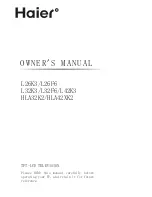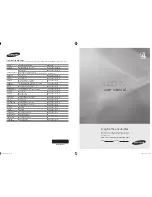
Circuit Descriptions, Abbreviation List, and IC Data Sheets
9.
about a “Field Comb Filter”. Field Comb filters are only for PAL
of commercial interest.
Field Comb filters show also problems on vertical colour
transients and on motion. For the vertical transients, a hanging
dots detector has been added, however the performance on
vertical transients of the field Comb filter, even with this
hanging dots detector, is worse than the performance of the 2D
Comb filter. On motion, the field Comb filter performs very
badly. A motion detector must detect the pixels where there is
motion and on these pixels, the Comb filter must be forced back
to 2D Comb filter mode. This switching back is not
implemented with a hard switch, but with a motion controlled
fader. When there is a lot of motion, the fader will take a lot of
the 2D Comb filter output, when there is less motion, more field-
combed signal will be taken.
A field Comb filter is also called a “vertical-temporal filter”
because it filters in the vertical and temporal direction.
Frame Comb Filter Mode
A Comb filter does an action on a current pixel and a delayed
pixel. When the delay is a frame, we talk about a “Frame Comb
Filter”. For NTSC we need a delay of one frame, for PAL
however the delay must be two frames.
Frame Comb filters have the best performance, but just like the
Field Comb filter, they perform very badly on motion. A motion
detector will have to detect motion and on these motion pixels,
2D Comb filtering will have to be applied. A frame Comb filter
is a pure “temporal filter”.
The Columbus needs an external memory connected to it,
before it can do a temporal or vertical-temporal Comb filter
action. When no external memory is connected, field or frame
Comb filtering is impossible.
Block Diagram
In the next block diagram, two main parts of the Columbus 2D/
3D Comb filter can be seen:
•
The upper part is what is called the luminance Comb filter.
It tries to make an as clean as possible luminance signal
out of the CVBS signal at the input.
•
The lower part receives U and V signals (sequentially) that
are normally only band pass filtered in front of the 3D Comb
filter. It filters all left over luminance signals out of it, in order
to make an as clean as possible U and V signal.
Figure 9-4 Columbus 2D/3D Comb Filter block diagram
The Comb filter has two inputs. One is the CVBS where clean
luminance (Y) will be extracted from; the other one is UV where
a clean U and V signal will be extracted. Both input signals are
digital
signals.
The field or frame delay is used for the Field and Frame Comb
filter mode. An external memory connected to the Columbus IC
provides this delay.
Phase correction is done at the inputs of both the Comb filter
blocks. There is a phase correction for spatial filtering (called
the spatial phase corrector) and a separate phase correction
on the signals used for temporal (Frame or Field) Comb filtering
(called the temporal phase corrector).
The offset block receives the motion dependant 2D/3D Comb
filtered signal as input. The black level of the luminance signal
is restored and the result is output. The black level restoration
is corrected continuously. However, on VCR signals, this
restoration can become unstable. Therefore, on VCR signals,
a fixed black level restoration value must be forced.
A horizontal dynamic peaking can be done on the luminance
signal. This peaking is adaptive in order not to amplify any
cross luminance distortion. It detects where there could be left
over sub carrier in the luminance signal and reduces the
peaking over there. The detection of the left over cross
luminance is different depending on the pre-filter or post-filter
mode.
The amount of peaking and coring can be chosen. The peaking
algorithm behind it is a simplified copy of the luminance
peaking of picnic. After the peaking block, the signal is output
as clean luminance.
The bypass switches have the obvious purpose of bypassing
the input signal, in case no Comb filtering is wanted.
A PAL delay line is added in the UV path. This is done because
a delay line in front of the 3D Comb filter does need an extra
vertical filter action on the UV signals. This vertical filtering
deteriorates the vertical transient performance for colours. The
Columbus Comb filter cannot undo this. However, this
reduction in performance can be omitted by putting the PAL
delay line after the 3D Comb filter block.
For PAL signals, the PAL delay line in front of the Columbus 3D
Comb filter is bypassed and the Columbus delay line is
switched “on”. In cases where the delay line in front of
Columbus cannot be bypassed, the Columbus PAL delay line
is bypassed.
For NTSC signals, the PAL delay line is bypassed as usual.
LUMINANCE
COMB FILTER
FIELD/FRAME
DELAY
OFFSET
Y-OUT
UV-OUT
(EXTERNAL SDRAM)
PAL
DELAY
LINE
HORIZONTAL
DYN
PEAKING
UV
COMB FILTER
UV-IN
CVBS-IN
E_14600_043.eps
230304
www.freeservicemanuals.info
















































